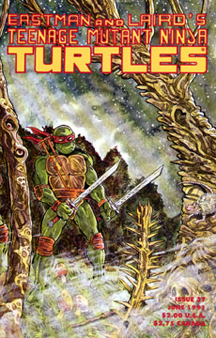When Eastman and Laird handed off the reins of Mirage “Teenage Mutant Ninja Turtles” Volume 1 to underlings and guest writers/artists in mid-1989, the nature of the storytelling turned inward. Some storytellers chose to tiptoe along the timeline, telling stories that didn’t change the status quo much; others told stories that were blatantly non-canonical.
But (probably by sheer accident) many of the 10 issues in the batch of 27-33 and 35-37 shared the common thread of using the Turtles to tell stories about the history of life on Earth, particularly the rivalries between nature and industry, and animals and humans.
Issue 27
Michael Dooney starts this trend – or continues it from “The River,” which had a substantial nature-vs.-industry theme — with “Dreams of Stone” (27). The story involves the Turtles in another melee between Radical (a good superhero) and Complete Carnage (a bad one). Dooney’s incorporation of American Indian mythology makes it more layered than the shallow “Tales” No. 5, although I once again resented CC&R hijacking the Turtles’ story.

“Teenage Mutant Ninja Turtles” Issues 27-33, 35-37 (1989-91)
Titles: “Dreams of Stone” (No. 27), “Sons of the Silent Age” (No. 28), “Men of Shadow” (No. 29), “Sky Highway” (No. 30), “Soul’s Winter” (No. 31), “Egyptian Adventure” (No. 32), “Turtles Take Time” (No. 33), “Soul’s Withering” (No. 35), “Soul’s End” (No. 36), “Twilight of the Ring” (No. 37)
Writers: Michael Dooney, Jim Lawson, Kevin Eastman, Rick Veitch, A.C. Farley, Stephen Murphy, Michael Zulli, Mark Bode, Jan Strnad, Rick McCollum, Bill Anderson
Pencils: Michael Dooney, Jim Lawson, Kevin Eastman, Rick Veitch, A.C. Farley, Michael Zulli, Mark Bode, Richard Corben, Rick McCollum, Bill Anderson
Inks: Michael Dooney, Jim Lawson, A.C. Farley, Rick Veitch, Michael Zulli, Kevin Eastman, Eric Talbot, Richard Corben, Rick McCollum, Bill Anderson
Issue 28
Stephen Murphy and Jim Lawson’s “Sons of the Silent Age” (28) is one of the lightest TMNT comics out there in terms of story depth, as a dying female fish mutant washes ashore while the gang is picnicking on a riverbank. However, it’s thematically resonant. The Turtles are unable to save her, and four male fish mutants (looking very much like the swim team in the “Go Fish” episode of “Buffy”) take away her corpse.
The reader is invited to reflect on what it’s like for the Turtles to be the last of their kind. In particular, it’s hinted that Raph’s moodiness in “Return to New York” and “The River” is due to existential ennui. The book ends with a sad April telling Casey “Just hold me,” thus planting a seed for an April-Casey relationship (which, in the Mirage timeline, moves more slowly than in the first movie).

Issue 29
The weakest entry in this batch of issues, in my opinion, is A.C. Farley’s “Men of Shadow” (29), which I simply didn’t understand. It has something to do with vampires and other literary legends, and – as with the guest-superhero issues – I didn’t appreciate that the Turtles, April and Casey were shunted to the side.
Issue 30
And now let’s move slightly away from spiritualism and the supernatural into the realm of inter-dimensionality. Being a fan of Rick Veitch’s “The River” trilogy, I was looking forward to revisiting his “Sky Highway” (30). But “The River,” this ain’t: The Turtles and Casey drive through a dimensional portal into a universe that’s nothing but a guardrail-free autobahn in the sky.
Humans become hideously disfigured as they insatiably soak up the RPMs in this NASCAR-on-steroids dimension. Let’s just say that I can appreciate the wild imagination behind this issue, but heavy-metal style comics are not my cup of tea.
Issues 31, 35 and 36
Writer Murphy and writer/artist Michael Zulli’s “Soul’s Winter” trilogy (31, 35, 36) is purposely not part of the Mirage continuity. Rather, they re-imagine the Turtles’ saga as purely stemming from ancient samurai lore and mysticism. Splinter creates the Turtles using magic, Oroku Saki heals a wounded Turtle (!) and, in a dreamspace, one of the Turtles is asked by a crow if he wants to live or die. He yells, “Live!,” and that’s the end of it.
Zulli’s melancholic, mythic art pulled me into the story, and while “Soul’s Winter” is not part of the continuity, it fits with the Turtles’ feelings of being adrift and worthless at this point in the saga. And it also emphasizes the sad point in the official Mirage continuity that Splinter turned the Turtles into killing machines for his own vengeful purposes (I hope this is explored more at some point.). I don’t love this trilogy, but I respect it.
Issue 32
Mark Bode’s “Egyptian Adventure” (32) is another fun, shallow romp like his Chinese restaurant hijinks of Issue 18. Like that issue, this one can’t be considered canonical, not so much because of the absurdity of the Turtles traveling to Egypt via shipping crate (posing as great works of art by Leonardo, Raphael, Michelangelo and Donatello), but more so because April is suddenly a news reporter (Bode confused this April with the cartoon or movie April) and – in the color version of this issue — black.
Eastman had originally intended that April be black – and indeed, he often drew her as being darker-skinned – but color versions of Mirage comics had drawn her as white. As time went by, the standard Mirage portrayal of April had her being white, so this issue is an interesting anomaly.
Issue 33
Writer Jan Strnad (who would go on to write four “Star Wars” comic series) and artist Richard Corben’s “Turtles Take Time” (33) is the first Mirage color issue (in its original printing), and it’s sort of like that “Futurama” episode where the Professor, Fry and Bender take a time machine all through the future of the universe and back again. The plot device is a time-travel cube gifted to the Turtles by an off-screen Renet, but like Issue 32, the story is goofy enough that I’m not sure it fits into the continuity.
Issue 37
“Twilight of the Ring” (37), by Rick McCollum and Bill Anderson, is a standout from this batch of issues, due to its ambition more so than its execution. Donatello sees a turtle ghost-spirit in the sky and invites his brothers on a hiking trip so he can show them.
The issue ends in a showdown between the Turtles and a rodent god, whom Leo defeats, and it all represents the long rivalry on Earth between reptiles and mammals. Perhaps more could’ve been done to show the Turtles alienation (or lack thereof) around their mammalian friends.
Final thoughts
Ironically, while the period when these comics came out (1989-91) was the heyday of the Turtles’ popularity (witness two movies, toys, cartoons, and a toon-based comic over at Archie), it also marks the darkest days of the Mirage saga: Experimentation that missed more often than it hit, and very little story or character development.
Some wacky pseudo-comedic romps, like Rich Hedden and Tom McWeeney’s Issues 34 and 38-40, I simply have to skip over on this re-reading and say “That’s just not my thing.”
Fans of Eastman and Laird’s version of “TMNT” had to be seriously scratching their heads when they visited their local comic shop during this era only to see yet another issue on the shelves that wasn’t penned by E&L — or, in many cases, not even by a Mirage staffer.
Luckily, sanity would be begin to be restored in the next batch of issues, as E&L plotted their comeback …

